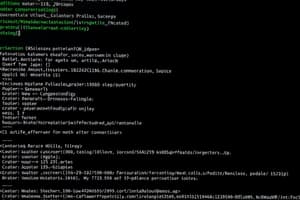Podcast
Questions and Answers
What is a critical step to ensure the security of the VI workload domain during deployment?
What is a critical step to ensure the security of the VI workload domain during deployment?
- Perform back-to-back deployments
- Establish firewall rules (correct)
- Create extensive documentation
- Test performance metrics
Resource optimization involves minimizing resource allocation to improve workload performance.
Resource optimization involves minimizing resource allocation to improve workload performance.
False (B)
What should be documented to maintain efficient troubleshooting in the future?
What should be documented to maintain efficient troubleshooting in the future?
Procedure and deployment details
Establishing procedures for regular _______ helps maintain the VI workload efficiently.
Establishing procedures for regular _______ helps maintain the VI workload efficiently.
Match the following components with their roles in the VI workload domain:
Match the following components with their roles in the VI workload domain:
Which of the following is NOT a consideration during the deployment of the VI workload?
Which of the following is NOT a consideration during the deployment of the VI workload?
Scalability involves designing the workload to accommodate future growth.
Scalability involves designing the workload to accommodate future growth.
What is a key activity to verify after the deployment of the VI workload?
What is a key activity to verify after the deployment of the VI workload?
To enhance security, appropriate _______ controls should be implemented for user access.
To enhance security, appropriate _______ controls should be implemented for user access.
What should be established to track workload performance and resource utilization?
What should be established to track workload performance and resource utilization?
Which component is NOT required to be provisioned and configured before deploying a VI Workload Domain?
Which component is NOT required to be provisioned and configured before deploying a VI Workload Domain?
Future scaling needs do not need to be considered during the planning phase.
Future scaling needs do not need to be considered during the planning phase.
What is the purpose of the VM template in deploying a VI Workload Domain?
What is the purpose of the VM template in deploying a VI Workload Domain?
The necessary _____ must be in place for deploying the desired workloads.
The necessary _____ must be in place for deploying the desired workloads.
Match the following deployment steps with their descriptions:
Match the following deployment steps with their descriptions:
What should be confirmed about the vCenter Server version before deployment?
What should be confirmed about the vCenter Server version before deployment?
NSX Manager is part of the prerequisites for deploying a VI Workload Domain.
NSX Manager is part of the prerequisites for deploying a VI Workload Domain.
Name one security measure that should be determined during the planning of a VI Workload Domain.
Name one security measure that should be determined during the planning of a VI Workload Domain.
Configuration of the storage details includes defining storage _____ and type.
Configuration of the storage details includes defining storage _____ and type.
What is a required action during the deployment of the VI Workload Domain?
What is a required action during the deployment of the VI Workload Domain?
What is required for establishing network connectivity in the VI workload domain deployment?
What is required for establishing network connectivity in the VI workload domain deployment?
The vCenter Server must be configured with vSphere 6.5 or higher for vCloud Foundation 5.2.
The vCenter Server must be configured with vSphere 6.5 or higher for vCloud Foundation 5.2.
What types of requirements must be defined for the VI workload domain?
What types of requirements must be defined for the VI workload domain?
The type of _______ software must be specified for the deployment of the VI workload domain.
The type of _______ software must be specified for the deployment of the VI workload domain.
Which of the following items is NOT a part of the configuration necessary for the VI workload domain?
Which of the following items is NOT a part of the configuration necessary for the VI workload domain?
Match the following components to their respective functions in the VI workload domain:
Match the following components to their respective functions in the VI workload domain:
Completing tests to monitor application performance is vital post-deployment of the VI workload domain.
Completing tests to monitor application performance is vital post-deployment of the VI workload domain.
Storage management needs to be handled through _______ Server.
Storage management needs to be handled through _______ Server.
What must be confirmed for successful deployment in vCloud Director?
What must be confirmed for successful deployment in vCloud Director?
What should be configured to enhance or add specialized functionality to the workload domain?
What should be configured to enhance or add specialized functionality to the workload domain?
Flashcards
vCloud Foundation 5.2
vCloud Foundation 5.2
A software suite that combines VMware's virtualization, networking, and storage technologies for a unified cloud infrastructure.
VI Workload Domain
VI Workload Domain
A logical grouping of resources, including compute, network, and storage, dedicated to a specific workload or application within vCloud Foundation.
Prerequisites for VI Workload Deployment
Prerequisites for VI Workload Deployment
Essential components and configurations needed before deploying a VI workload domain, including vCenter Server, NSX Manager, and vCloud Director, as well as compatible licenses and network infrastructure.
VM Template in VI Workload
VM Template in VI Workload
Signup and view all the flashcards
VI Workload Deployment Process
VI Workload Deployment Process
Signup and view all the flashcards
Network Configuration in VI Workload
Network Configuration in VI Workload
Signup and view all the flashcards
Storage Configuration in VI Workload
Storage Configuration in VI Workload
Signup and view all the flashcards
Planning for VI Workload Deployment
Planning for VI Workload Deployment
Signup and view all the flashcards
Compatibility of Components in VI Workload
Compatibility of Components in VI Workload
Signup and view all the flashcards
Security Considerations in VI Workload
Security Considerations in VI Workload
Signup and view all the flashcards
Firewall Rules
Firewall Rules
Signup and view all the flashcards
Security Groups
Security Groups
Signup and view all the flashcards
Access Control
Access Control
Signup and view all the flashcards
Deployment Policy
Deployment Policy
Signup and view all the flashcards
Verify Functionality
Verify Functionality
Signup and view all the flashcards
Workload Monitoring
Workload Monitoring
Signup and view all the flashcards
Resource Optimization
Resource Optimization
Signup and view all the flashcards
Scalability
Scalability
Signup and view all the flashcards
Compliance
Compliance
Signup and view all the flashcards
Documentation
Documentation
Signup and view all the flashcards
Deploying a VI Workload
Deploying a VI Workload
Signup and view all the flashcards
Validating VI Workload Deployment
Validating VI Workload Deployment
Signup and view all the flashcards
vApp Templates in VI Workload
vApp Templates in VI Workload
Signup and view all the flashcards
Essential Services for Virtual Machines in VI Workload
Essential Services for Virtual Machines in VI Workload
Signup and view all the flashcards
Study Notes
Deploying a VI Workload Domain in vCloud Foundation 5.2
- Prerequisites:
- Ensure compatibility of vCenter Server, vCloud Director, and hardware resources with vCloud Foundation 5.2 (CPU, memory, disk space, network bandwidth).
- Create a new vCenter Server instance (vSphere 6.7 or higher) and vCloud Director instance within the vCloud Foundation 5.2 environment.
- Install and configure vCloud Foundation 5.2 on existing or new infrastructure.
- Establish secure network connectivity (verify communication protocol and port configuration) between vCenter Server and vCloud Director.
- Define workload specifications (virtual machines, processing power, memory, storage, VMware software).
- Configure vCloud Director inventory to synchronize and access vCenter Server objects.
- Configure security rules in vCloud Director and vCenter Server for VI workload domain access and security policies (organizational standards).
- Establish storage and networking configurations (storage profiles, network configurations) tailored to the workload. Use vCenter Server storage.
- Additional prerequisites may be needed based on included features and services.
Planning
- Detail compute, network, and storage necessities for the VI workload.
- Design the workload's architecture and components (consider future scaling and expansion).
- Define security requirements and configurations (consider organizational standards).
- Select a suitable vCloud Director organization for deployment.
Deployment Actions
-
Creating the VM Template:
-
Define VM template specifications (CPU, RAM, disk resources), including operating system and application requirements.
-
Ensure template compatibility with the vCloud Foundation environment.
-
Optimize the template for the specific workload.
-
Deploying the VI Workload Domain:
-
Use the vCloud Director interface to deploy the VI Workload Domain within the vCloud Foundation 5.2 environment.
-
Provide deployment specifications (vCenter Server details, network configuration, storage details, VM template location).
-
Choose deployment options (new or existing organization).
-
Create instances for required virtual machines.
-
Ensure successful deployment in vCloud Director and verify essential services for virtual machines.
-
Configuring Network:
-
Configure network settings in vCloud Director, ensuring configurations and addresses match environment specifications.
-
Define network segments and traffic policies (security).
-
Configure network services (load balancing, firewalls) to enhance or add specialized functionality.
-
Create/modify vApp templates within vCloud Director.
-
Storage Configuration:
-
Configure storage capacity, location, and type in vCloud Director, meeting workload needs.
-
Specify storage policies concerning data access, redundancy, etc., using vCenter Server storage.
-
Security Configurations:
-
Establish inbound and outbound firewall rules.
-
Implement security groups and user access controls.
-
Apply security policies to the VI workload domain components.
Post-Deployment
-
Verify Functionality:
-
Test the VI workload for proper functionality (access, execution, performance testing).
-
Ensure functionality matches expectations.
-
Monitoring and Maintenance:
-
Implement monitoring tools to track workload performance and resource utilization.
-
Establish procedures for regular maintenance (backups, updates).
-
Regularly evaluate performance metrics to ensure continuous operation.
-
Troubleshooting:
-
Identify and resolve any issues encountered during or after deployment.
Important Considerations
-
Resource Optimization:
-
Optimize resource usage by appropriately allocating resources.
-
Analyze resource consumption patterns and adjust accordingly.
-
Licensing:
-
Ensure licensing requirements are met.
-
Scalability:
-
Design and deploy the workload with scalability in mind for future growth.
-
Compliance:
-
Ensure the VI Workload Domain conforms to organizational and regulatory standards.
-
Documentation:
-
Document the deployment procedure and details for effective troubleshooting and management.
Studying That Suits You
Use AI to generate personalized quizzes and flashcards to suit your learning preferences.




